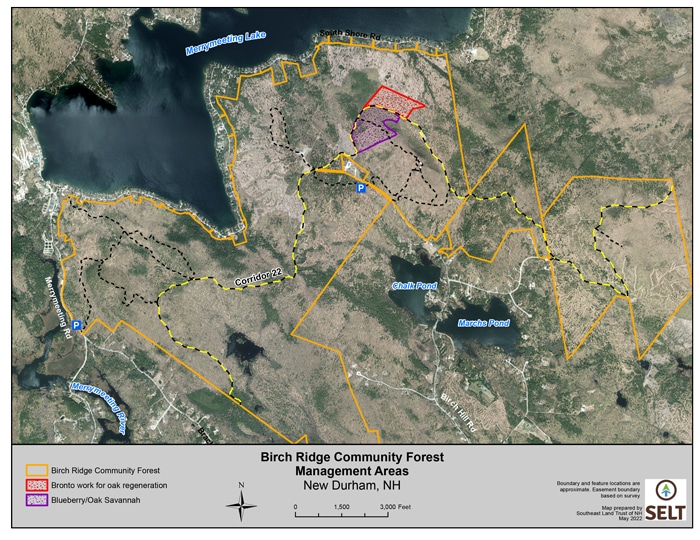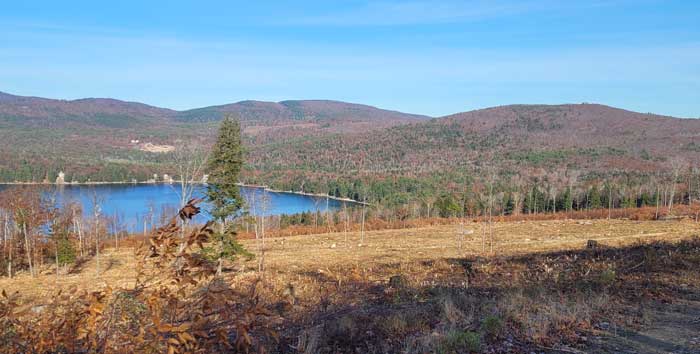If you have spent time at Merrymeeting Lake lately, you may have noticed changes along Birch Ridge due to recent management activities.
The cut that you see is a prescribed activity in the management plan for Birch Ridge adopted by the Birch Ridge Community Forest Steering Committee. When the Community Forest was established, the forest had been very heavily cut by the prior owners, so we can understand the surprise that some may have felt when viewing Birch Ridge. The cut consists of two adjacent treatments, each with different goals of 1) encouraging red oak and 2) encouraging blueberries. Each of these areas and goals are explained below and shown in the following map.

Encouraging Red Oak: The smaller area (outlined as red in the map) is 21 acres in size and was cut in the late fall with a flailing head mower attached to an excavator (or as we call it a “brontosaurus”). The goal here was to return this area into a red oak forest. One of the challenges of a heavily cut property like Birch Ridge is that beech can become an unwanted dominant species due to its ability to resprout, but also because beech spread via root suckers as well.
A beech dominated forest is not a desired long-term outcome per the adopted management plan. To redirect the forest to the red oak dominated forest (which is what it was before the cut and what the management plan is striving for), we need to give the red oak a leg up in regenerating via the brontosaurus treatment.
This decision was guided by consultation with our forester Jon Martin and informed from New Hampshire research done by U.S. Forest Service scientists Ken Demarais and Mariko Yamasaki that indicates cutting everything back when red oak is smaller will promote its growth at a faster rate than the surrounding trees, in this case beech. Through this cut, we expect red oak will be at an advantage and outcompete neighboring tree species, including beech. This will also provide early successional habitat (which is habitat in decline in New Hampshire that is important for migrating song birds, grouse, woodcock, rabbit, and other species) for the next 10+/- years as the forest grows.
Encouraging Blueberries: Adjacent to the first area is a portion of the former blueberry barrens that was once a commercial blueberry operation on the property. This area (outlined in purple on the map) was cut after Christmas. With oversight from wildlife biologists Charlie Bridges and Lee Alexander (both of whom are members of the Birch Ridge Community Forest Management Committee), we’ve completed a 36-acre cut here that seeks to return a portion of the areas to blueberries (for wildlife and people to pick) while keeping larger crowned oak trees as mast/seed trees.
In addition, if there were larger beech that could serve as mast sources for bear, they were kept as well. It visually looks like an oak-savannah – so if you were to visit this area, you would see scattered single or clumped trees on the density of 5-7 per acre, with an understory of blueberry and other shrubs. Future management in this area will be determined after we see how the blueberry responded. You also may notice some additional work in this location over this summer as a hiking/biking trail over Birch Ridge is completed to connect to Corridor 22 and a short snowmobile trail is established to allow for them to take a side trip off Corridor 22 to enjoy the view.
Keep an eye on our webpage on Birch Ridge with more detailed information, where you can read and review the management plan and meeting materials for the Birch Ridge Management Committee. In the future we hope to include a dynamic map that allows you to click on certain areas, see photos, and read about what is happening or is planned.
Updated 6-2-2022

